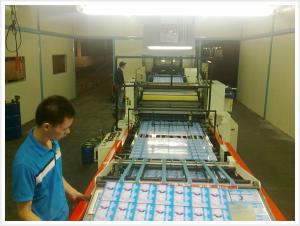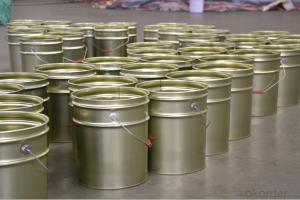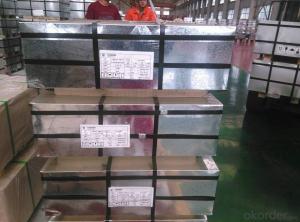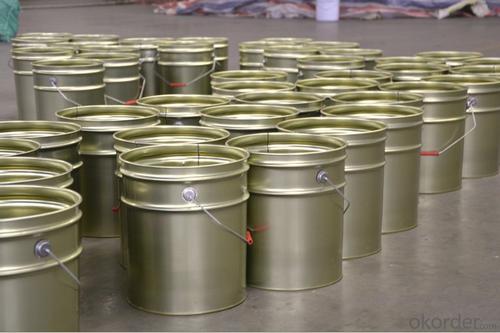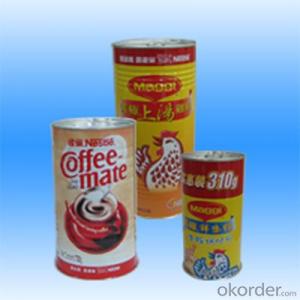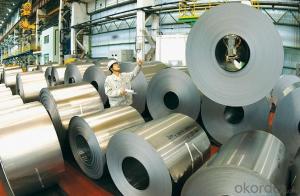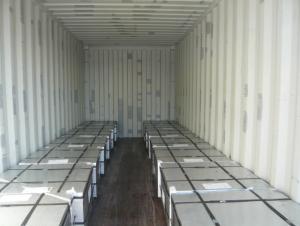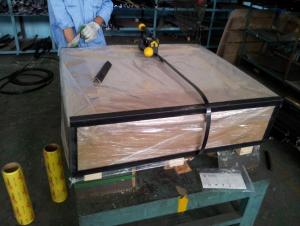Printed Tinplate, MR JIS G3303, Metal Package
- Loading Port:
- Tianjin
- Payment Terms:
- TT OR LC
- Min Order Qty:
- 25 m.t.
- Supply Capability:
- 40000 m.t./month
OKorder Service Pledge
OKorder Financial Service
You Might Also Like
1.Usage
Tinplate is widely used for making all types of containers, containing industrial usage such as paint can, oil can, aerosol cans etc., and food cans like milk powder cans, tomato paste can, dry food cans etc.
2. Quality
As a state owned company and a large tinplate supplier in China, our tinplate quality ranks 1st level in China, similar to Bao Steel, Posco etc.
3. Specification
standard: GB/T2520, JIS G3303, DIN EN10202
Material: MR /SPCC
Thickness available: 0.16-0.50MM
Width available: 600~1050MM
Temper grade: T1 – DR8
Tin coating: ordinary 2.8g/2.8g, 5.6g/5.6g and others
Package: sea worthy export package.
Applications: Tin can for chemicals & paint cans, industrial cans, food cans
4. Our factory photo & equipments

5. Our Markets:
now our tinplate has been sold to more than 50 countries, including Europe country, Gulf Area, South American, South Afric etc.
6. Our Overseas Wareouses:
Furthermore, in the year 2014, we have more than 10 overseas warehouses all over the word, located in KSA, UAE, Oman, Russia, Kuwait, Qatar, Oman, Chile, Brazil etc.
7. FAQ
a. what's the annual output?
about 500,000 tons per year.
b. where's the raw matrial from?
our hot rolled coil is purchased from Capital Steel and other state owned mill, with quite good quality.
c. how long is the delivery time?
normally for SPCC about 45~55 days, while 65~75 days for MR material
d. how to control the quality during production process?
inside our workshop, we have MES syestem. It realizes the optimization of the production procedure in the workshop. It could record each step of the whole production procedures, and if some problem appears, factory could easily found and take action, it’s quite helpful to monitor and control the quality.
- Q: Can tinplate be used for microwaveable packaging?
- No, tinplate cannot be used for microwaveable packaging.
- Q: How is tinplate coated with organic materials for specific applications?
- Tinplate is coated with organic materials for specific applications through a process known as lacquering. Lacquering involves applying a thin layer of organic material, such as a resin or polymer, onto the surface of the tinplate. This coating provides protection against corrosion, enhances the aesthetic appearance, and improves the adhesion of inks or paints for printing or labeling purposes. The organic coating can be applied through various methods like roll coating, spray coating, or electrostatic deposition, depending on the specific requirements of the application.
- Q: What are the challenges faced in the recycling of tinplate?
- One of the main challenges in the recycling of tinplate is the separation of tin from steel. Tin is a valuable material and it is important to recover it efficiently. However, the process of separating tin from steel can be complicated and time-consuming. Additionally, the presence of other contaminants in tinplate, such as paint or other coatings, can further complicate the recycling process. Another challenge is the collection and sorting of tinplate waste, as it often ends up mixed with other materials in the general waste stream. This makes it harder to recover and recycle tinplate efficiently. Overall, the challenges in the recycling of tinplate involve the efficient separation of tin from steel and the collection and sorting of tinplate waste.
- Q: How does tinplate contribute to the reduction of food waste?
- Tinplate contributes to the reduction of food waste by providing a highly protective and durable packaging material for various food products. Its corrosion-resistant properties and ability to maintain food freshness for extended periods help to prevent spoilage and extend shelf life. Additionally, tinplate's ability to be easily recycled promotes sustainable packaging practices, reducing environmental impact and further supporting efforts to minimize food waste.
- Q: What are the advantages of using tinplate for stationery?
- There are several advantages of using tinplate for stationery. Firstly, tinplate is highly durable and resistant to corrosion, ensuring that the stationery items made from it will last longer. Secondly, tinplate is a lightweight material, making it convenient to carry around and use. Additionally, tinplate is easily recyclable, making it an environmentally friendly option. Lastly, tinplate can be easily decorated and customized, allowing for unique and attractive designs on stationery products.
- Q: How does tinplate perform in terms of corrosion resistance compared to other materials?
- Tinplate generally has a good level of corrosion resistance compared to other materials, especially when it is properly coated with tin. The tin coating acts as a protective barrier, preventing direct contact between the base metal (usually steel) and the surrounding environment. This helps to minimize the impact of moisture, oxygen, and other corrosive elements on the tinplate surface. However, it is important to note that the level of corrosion resistance can vary depending on the thickness and quality of the tin coating, as well as the specific application and exposure conditions.
- Q: Can tinplate be used for automotive parts?
- Yes, tinplate can be used for automotive parts. It is often used for components such as body panels, fuel tanks, and exhaust systems due to its corrosion resistance and durability.
- Q: What are the main challenges in tinplate labeling?
- The main challenges in tinplate labeling include ensuring the label adheres well to the curved surface of the tinplate, maintaining label durability and resistance to moisture and other external factors, achieving accurate and consistent placement of the label, and ensuring the label does not peel or bubble over time.
- Q: What are the main challenges in tinplate storage and transportation?
- The main challenges in tinplate storage and transportation include ensuring proper protection against rust and corrosion, maintaining temperature control to prevent damage to the tinplate, preventing stacking or handling errors that may result in dents or scratches, and ensuring efficient logistics to minimize delays and damage during transportation. Additionally, complying with safety regulations and maintaining adequate inventory management are also significant challenges in tinplate storage and transportation.
- Q: How is tinplate coated with water-based paints?
- Tinplate is coated with water-based paints using a process called coil coating. In this process, the tinplate is cleaned and then coated with a primer layer, which helps in improving adhesion. After the primer layer, multiple layers of water-based paints are applied using rollers or spray techniques. These layers are then dried and cured to form a strong and durable coating on the tinplate surface.
Send your message to us
Printed Tinplate, MR JIS G3303, Metal Package
- Loading Port:
- Tianjin
- Payment Terms:
- TT OR LC
- Min Order Qty:
- 25 m.t.
- Supply Capability:
- 40000 m.t./month
OKorder Service Pledge
OKorder Financial Service
Similar products
Hot products
Hot Searches
Related keywords
